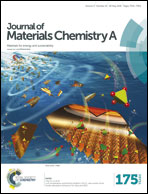Ruthenium@mesoporous graphene-like carbon: a novel three-dimensional cathode catalyst for lithium–oxygen batteries†
Abstract
Nonaqueous lithium–oxygen (Li–O2) batteries are considered as the most promising energy storage systems, because of their very high energy densities, which are significantly greater than those of lithium-ion batteries. Recently, carbon materials have been widely used as cathode catalysts for Li–O2 batteries due to their outstanding conductivity. However, side reactions are inevitable when the carbon materials are exposed to the Li2O2 product and the organic electrolytes, leading to degradation in their cycling performances. Herein, we propose a simplified strategy, which combines the template method and in situ growth approach in order to establish a three-dimensional (3D) mesoporous graphene-like carbon structure, and growth of a uniform layer of ruthenium particles on it. The as-prepared 3D ruthenium@mesoporous graphene-like carbon material delivers a reversible capacity of about 6433 mA h g−1 (based on the total mass of the composite) at a current density of 200 mA g−1, when it is used as a cathode catalyst for Li–O2 batteries. Under a curtaining capacity of 500 mA h g−1, it exhibits an extremely low charge voltage of 3.20 V (only 240 mV higher than the thermodynamic potential) and a high discharge voltage of 2.84 V at a current density of 100 mA g−1.


 Please wait while we load your content...
Please wait while we load your content...